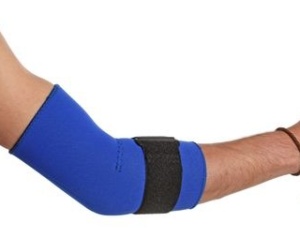2. Tennis elbow treatment
4. Elbow pain – advice for tennis players
Rest
As described in my previous article, tennis elbow is essentially an overuse injury, so the first line of treatment is obvious: break the vicious circle and give the tendon a chance to heal. This is often all that is required and many cases of tennis elbow are short-lived provided the tendon is given a chance!
However, keen sportsmen and women are notoriously bad at this. There is a great tendency to rest briefly until the pain starts to ease off and then go back to abusing the poor tendon before it has had a chance to heal properly.
In the acute phase, as with any injury, rest may be combined with ice and pain-killers.
Tennis elbow clasp
 The principle of a counterforce brace is simple: to off-load the tendon by spreading the force of muscle contractions around the forearm. Some people do seem to find them helpful, but others do not and there is no good scientific evidence to support their effectiveness. They are however a safe and inexpensive treatment option.
The principle of a counterforce brace is simple: to off-load the tendon by spreading the force of muscle contractions around the forearm. Some people do seem to find them helpful, but others do not and there is no good scientific evidence to support their effectiveness. They are however a safe and inexpensive treatment option.
They can also be used to protect the tendon when returning to sport.
Physiotherapy
Does physiotherapy work for tennis elbow? Well it rather depends on what it involves. There is good evidence that eccentric strengthening programmes can be beneficial in many tendonopathies. The mechanism is incompletely understood, but these exercises may abolish the abnormal small blood vessels seen in tendonapathies as well as improving the collagen structure of the diseased tendon. Much of the initial research was performed for achilles tendonopathies. However there is now also reasonable evidence that gradual eccentric stenghthening of the wrist extensor muscles can be effective in tennis elbow.
Most exercises are concentric, which means that the muscle contracts as its fibres shorten. “Eccentric” means that the muscle is worked against resistance as the fibres lengthen (ie: as the muscle slowly relaxes). To work the wrist extensors eccentrically, you need to sit with your forearm resting on a table and your hand hanging off the edge, palm down. You then use your other hand to passively lift up your wrist on the affected side. The latter is then slowly lowered in a controled fashion. This is then repeated. You should start with a very light weight (or even no weight) in your hand and slowly increase this over time. A cheap and easy way to do this is with a small plastic bottle which can be filled with water to gradually make it heavier.
. . .
Three simple exercises for tennis elbow
The key to this is that it should be a gentle and gradual process. Do not be tempted to increase the weights too rapidly. There may be some aching after the exercise session. However if there is significant pain, it is important to rest for a day or two and then restart with a lighter weight.
A physiotherapist will be able to tailor this regime to suit your symptoms and also add in other exercises as required.
Steroid (cortisone) injections
This is often seen as a first line medical treatment for tennis elbow. However the main mode of action of steroids is as a powerful anti-inflammatory, yet tennis elbow is not an inflammatory condition. It is a degenerative condition caused by wear and tear of the tendon, and steroid injections can actually cause further weakening of the degenerate tendon.
A recent randomised controlled trial showed that whilst steroid injections can provide good short term relief, their effect after six weeks was no better than a “wait and see” approach and was inferior to physiotherapy alone. In fact at one year, there was no significant difference between the three treatment groups, with most patients reporting a favourable outcome.
Steroid injections should therefore be used with caution, though they may still have a limited role in relatively acute tennis elbow when combined with other treatment modalities.
Platelet rich plasma (PRP) injections
Over the past few years, PRP has emerged as an exciting new treatment for chronic tendon problems including tennis elbow and golfer’s elbow. It uses the body’s own healing growth factors, contained in the blood, to encourage the degenerate tendon to heal itself. It is increasingly being used by high level sportsmen both in the treatment of chronic tendon problems and also to try and speed up the healing of more acute tendon injuries. It has reportedly been used by Rafa Nadal and Tiger Woods, as well as a number of top football teams.
Extra-corporeal shock wave treatment (ESWT)
ESWT is another relatively new non-operative treatment which is increasingly used to treat tennis and golfer’s elbow. It relies on high energy sound waves to reduce pain and stimulate tendon healing.
Surgery – tennis elbow release
Most cases of tennis elbow are self-limiting and do not require an operation. However where symptoms have been present for more than six months and have failed to respond to non-operative treatment, then tennis elbow release surgery may be considered. This is not a major operation and can usually be performed as a day-case, but it does require a general anaesthetic. Maximal recovery typically takes three to six months.
3. Surgery for tennis elbow Next >>
